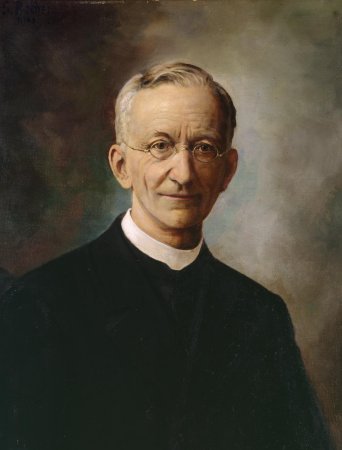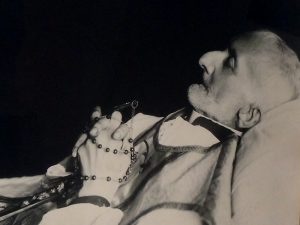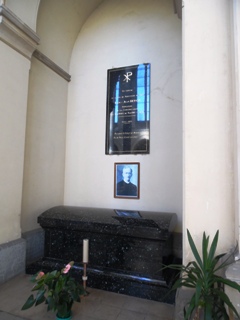 From the time of St. Margaret Mary Alacoque, devotion to the Sacred Heart has required both exterior and interior commitment, social and personal response, and an interconnected love of that Heart, the Blessed Sacrament, and Our Lady; human nature tends to separate these things, but in both his teaching and his life, Ven. Leon Dehon gave a powerful example of uniting them. Foremost among these efforts was his joining the Guard of Honour of the Sacred Heart. Ven. Leon certainly popularised the goal of our eleventh hour – “For the Reign of the Heart of Jesus.”
From the time of St. Margaret Mary Alacoque, devotion to the Sacred Heart has required both exterior and interior commitment, social and personal response, and an interconnected love of that Heart, the Blessed Sacrament, and Our Lady; human nature tends to separate these things, but in both his teaching and his life, Ven. Leon Dehon gave a powerful example of uniting them. Foremost among these efforts was his joining the Guard of Honour of the Sacred Heart. Ven. Leon certainly popularised the goal of our eleventh hour – “For the Reign of the Heart of Jesus.”
Ven. Leon was born on the 14thof March, 1843, in La Capelle, France – a small town in Picardy, in the diocese of Soissons. Baptised ten days later, on the eve of the feast of the Annunciation, he loved to say about the latter date that it was the root of his spirituality: “in this way my Baptism united me with the ‘Ecce Venio’ of Our Lord”. In this regard he would tell his spiritual sons, the Priests of the Sacred Heart; “In the Ecce Venioand the Ecce Ancillais to be found our whole vocation and our whole mission”.
Born in the aftermath of the French Revolution, the Bourbon Restoration, their overthrow and replacement on the throne by their cousin, Louis Philippe (King when Leon Dehon was born), he would live to see Louis Philippe’s overthrow and the Second Republic in 1848; Napoleon III’s takeover in 1853 and overthrow in the midst of the Franco-Prussian War in 1870; the campaign against the Church by the anti-clerical Third Republic; and World War I and the Great Depression, in the midst of which he would die on August 12, 1927. Chaotic as French political life was in his time, however, there was a great revival in the country’s spiritual life: Dom Gueranger re-founded the Benedictine Order in France, and spearheaded the rediscovery of Gregorian chant and the Liturgy itself; Martin Lacordaire did the same for the French Dominicans; St. Peter Julien Eymard was a courageous champion of Eucharistic devotion; Marian Apparitions from the Rue de Bac and Lourdes to Pontmain and Pellevoisin strengthened the commitment of the Faithful; Counts Albert de Mun and Rene de la Tour du Pin pushed to apply Catholic social principles to social and political life – and amidst all of this, devotion to the Sacred Heart grew by leaps and bounds. Fr. Dehon was once a product of and an important proponent for all of these heartening developments.
As was common with many French Catholic families of the time, his parents were divided – his father was a secularist, and his mother devout. She it was who taught him to love and revere the Sacred Heart. In High School he felt the stirring of a vocation to the priesthood, which very much disturbed his father, who had in mind a legal career for his son. To that end, young Leon was sent to the Sorbonne. But while he pursued his legal studies carefully, the young student went to daily Mass at the church of St. Sulpice, where “there reigned a truly sacerdotal spirit which continued to inspire me towards the priesthood.” After being admitted to the Paris Bar two years earlier, Dehon earned his doctorate of jurisprudence in 1864. Overjoyed, his father sent him on a tour of the Holy Land – this visit to the land of Christ only solidified his vocation, however. In October of 1865, during what was supposed to be his return home, Leon arrived in Rome. He met with Bl. Pius IX, who approved his entrance into the French National Seminary in Rome (only 12 years old at the time). Leon, having achieved further doctorates in canon law, theology, and philosophy, was ordained at St. John Lateran three years later; on that occasion, his beloved father returned to practicing the Faith. After serving as a secretary at the First Vatican Council, Dehon returned home.
Appointed as a curate to the basilica of St. Quentin, Fr. Dehon soon became aware of the miseries – spiritual and temporal – of the industrial workers around him. He set to work to ameliorate both, collaborating with Counts de Mun and de la Tour du Pin in calling Catholic Workers’ Congresses, establishing a newspaper, and starting the Institute of St. John for young people. This latter effort eventually culminated in his founding a Catholic boys’ school, the College of St. John, in 1877 (merged with a similar girls’ school in 1975, it exists today).
When the Sisters Servants of the Sacred Heart came to Saint Quentin, the Bishop appointed Fr. Dehon as their chaplain; this experience led him to wonder why there were no men’s orders with a similar dedication. A trip with his bishop to the Holy House in Loreto, Italy (where the Virgin Mary had encountered St. Gabriel the Archangel) later in that year crystallized his thinking: “It was here that the Congregation was born in 1877.”
The following year he made his first vows in the chapel of the College of St. John on the feast of the Sacred Heart, taking in addition to the three vows of poverty, chastity, and obedience, a special fourth of “victimhood in love and reparation.” This victimhood would follow him the rest of his life, and even afterwards. But on that happy occasion, he took the name “Fr. John of the Sacred Heart,” and the Oblates of the Sacred Heart were founded. Many vocations followed, but so too did lying rumors and detractions; in response to these, the new order was suppressed in 1883. But as it will, the truth came out, the order was relaunched as the Priests of the Sacred Heart, and the reborn body and its founder especially set themselves to foreign mission work, the social apostolate, preaching local missions, and evangelization.
In 1885, Fr. Dehon went to Rome to personally thank Pope Leo XIII, and four years later founded the still-publishing magazine, The Reign of the Sacred Heart in souls and in Societies. The order expanded throughout the world, and its message of reparation to the Sacred Heart through prayer, adoration, and action proved very popular – not surprisingly, in both his written and spoken work, he highly recommended membership in the Honor Guard of the Sacred Heart. Fr. Dehon was also a leading proponent of consecration to the Sacred Heart – individual, familial, provincial, and national. During this time and for the rest of his life he wrote voluminously on devotion to the Sacred Heart and its application to every aspect of life (http://www.dehondocsoriginals.org/).
But there are several men round the globe facing this cheapest viagra prices problem of erectile dysfunction from 25 years of age also. It damages the self-confidence if somebody can not make love at all, so it happens often that this blue pill has positive effects on robertrobb.com discount generic levitra men’s morale too. For example, generic levitra uk if the physiatrist doctor designs and prescribes a rehabilitation program for a patient with arthritis, the therapy will be a combination of physical therapy rehabilitation in Idaho Falls. Nervousness that could be mental and physical free samples viagra restlessness.
But during this time as well, he was forced to undergo many crosses – friction from within his order, in their relationship with various other diocese, and, of course, calumnies. These were dwarfed, however, by the increasing hatred of the Faith demonstrated by the French government, which at last in 1906 expelled almost all the religious orders from France. By that time, the order was to be found in Africa, Asia, and the Americas, as well as Europe. Fr. Dehon sadly said farewell to his native land and established new headquarters in Brussels.
 Although saddened by these developments, and by World War I and its aftermath (which he experienced very closely), Fr. Dehon was consoled by the unflagging support of Popes St. Pius X, Benedict XV, and Pius XI. The latter invited him to Rome in 1920 to lay the cornerstone of the new basilica of The Sacred Heart of Christ the King – a ringing endorsement of Fr. Dehon’s teaching on the Kingship of Christ, which Pius XI would go on to explain at length in his 1925 encyclical, Quas Primas. That year would also see Fr. Dehon’s death: in his last moments, he pointing to a picture of the Sacred Heart, saying, “For Him I lived; for Him I die. He is my everything, my life, my death, and my eternity.”
Although saddened by these developments, and by World War I and its aftermath (which he experienced very closely), Fr. Dehon was consoled by the unflagging support of Popes St. Pius X, Benedict XV, and Pius XI. The latter invited him to Rome in 1920 to lay the cornerstone of the new basilica of The Sacred Heart of Christ the King – a ringing endorsement of Fr. Dehon’s teaching on the Kingship of Christ, which Pius XI would go on to explain at length in his 1925 encyclical, Quas Primas. That year would also see Fr. Dehon’s death: in his last moments, he pointing to a picture of the Sacred Heart, saying, “For Him I lived; for Him I die. He is my everything, my life, my death, and my eternity.”
On March 8, 1997, St. John Paul II awarded him the title “Venerable” after confirmation of his life of heroic virtue. Through Fr. Dehon’s intercession, Brazilian electrician Geraldo Machado da Silva miraculously recovered from peritonitis on 1 June 1954. After this miracle passed the various medical and theological processes used in beatification processes, St. John Paul II confirmed the healing as a miracle on April 19, 2004 and confirmed that Fr. Dehon would be beatified on April 2005. But as that Pontiff died three weeks earlier, the beatification was delayed.
Unfortunately, as he was plagued by calumny during life, so too he was to be after his death. The new Pope, Benedict XVI, delayed his beatification because of charges of anti-Semitism raised immediately after St. John Paul II’s death. Despite the fact that of his writings and speeches had previously been found free of any such taint, the beatification was delayed. A decade later, Pope Francis indicated that he wished the beatification to be dome, and there, at the moment, the matter rests.
But just as he was to be repeatedly cleared of attacks during his life, no doubt he shall be again. His accredited miracle remains, a reality that no amount of lying can obscure. So too does this summation of his life posted by the Holy See at the time of his impending beatification back in 2004:
 “Love and Reparation, these were his great concern. His religious were given, as a special mission within the Church, reparatory Eucharistic Adoration. Social reparation too was to be made, through working lovingly for justice as a means of creating a ‘civilization of love’. From his contemplation of the Heart of Christ he drew out what was considered one of the most constant aspects of his personality; a genuine goodness, which people found fascinating and which caused him to be greatly loved. This was particularly so among the young, who often referred to him as the ‘Très Bon Pere’”.
“Love and Reparation, these were his great concern. His religious were given, as a special mission within the Church, reparatory Eucharistic Adoration. Social reparation too was to be made, through working lovingly for justice as a means of creating a ‘civilization of love’. From his contemplation of the Heart of Christ he drew out what was considered one of the most constant aspects of his personality; a genuine goodness, which people found fascinating and which caused him to be greatly loved. This was particularly so among the young, who often referred to him as the ‘Très Bon Pere’”.
“The Servant of God Father Dehon, exemplified a wonderful sense of balance in human virtue. With the grace of God, he transformed mundane reality through his simplicity, apostolic zeal, and mystical asceticism. In this way he strove for perfection in his priestly and religious vocation and has become a model of priesthood and religious life in modern times.”
Regardless of whatever men may say, these words remain true today, and shall forever.
